
B369-Young-Learners-Activity-Book_v10
.pdf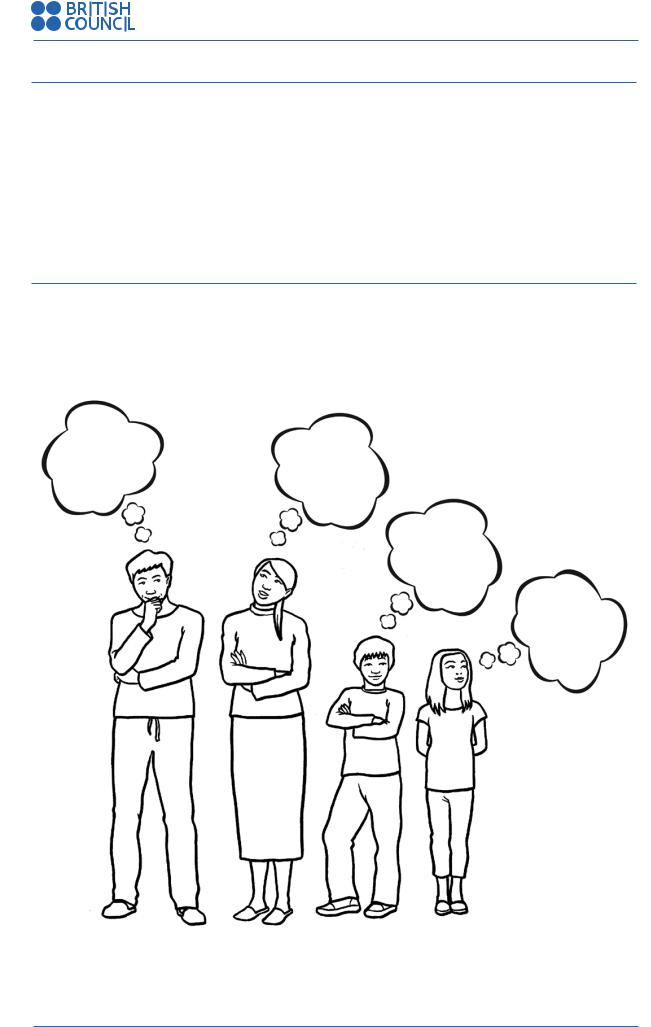
TeachingEnglish Young Learners Activity Book
Activities
Alternatives
•You can prepare family cards for the buyers rather than buyers describing their own family. The buyers then decide what kind of house they need based on the descriptions.
•You can use pictures/house plans from estate agents (real estate). Sellers then have to decide which house they want to try to sell.
•This activity can also be done with shops. Each group of sellers must decide what sort of shop they own and what they sell in their shop. Each group of buyers prepares a shopping list and then goes around the shops and tries to buy all the items on the shopping list.
No resources?
Few resources are needed for this, just some blank paper and pens.
I want a |
I want a |
|
garage |
||
garden |
||
|
I want a big bedroom
I want lots of trees
© British Council 2012 |
79 |
|
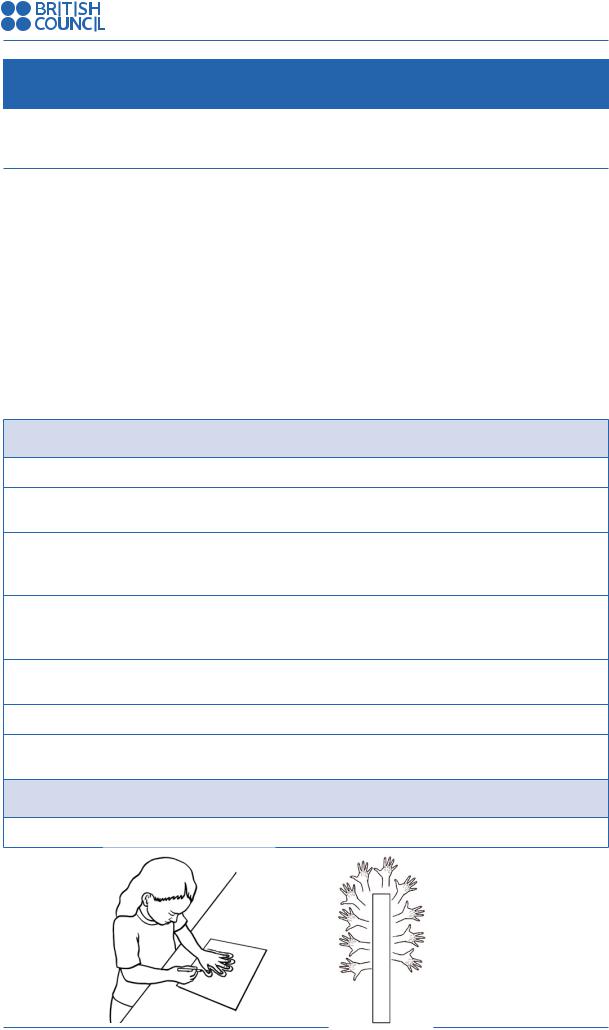
TeachingEnglish Young Learners Activity Book
Activities
Activity 37: The noun tree
Hasmik Perosyan – Armenian Republic
Age: 8–15  20–25 minutes Large classes? No Mixed level? Yes
20–25 minutes Large classes? No Mixed level? Yes
Materials: Board and stickers.
Organisation: Whole class.
Aim: To practise pronouncing words and to develop written texts.
Description: The teacher draws a large tree and the children provide ‘leaves’ or ‘fruit’ by writing nouns on pieces of paper to stick on the tree. The nouns are then made into sentences, and the sentences into stories.
Preparation: You will need to cut sticky notes or pieces of paper into the shapes of leaves and fruit, one for each child.
Procedure
1.Draw a large tree on the board with many branches.
2.Ask the children what is missing from the tree and elicit either ‘fruit’ or ‘leaves’. Tell the children they are going to provide the fruit or leaves to the tree.
3.Give each child a piece of paper or sticky note cut into the shape of a leaf or a fruit. Ask each child to think of a noun that they like in English and can say well and to write it on the paper.
4.Ask each child to come up to the board with their leaf or fruit. Ask the child what noun they have chosen and ask them to say it loudly with the correct pronunciation. They can then stick it on the tree.
5.Now ask either the child or the class to make a sentence with the noun. The sentence can be written on the board (by the teacher or by another child) or in the children’s books.
6.Continue until all the nouns are on the tree and all the sentences written.
7.Now ask the children to choose some of the sentences (you can say how many) to include in a story. The best story gets a prize.
Notes
If you have an interactive whiteboard, you can prepare the tree in advance.
80 |
© British Council 2012 |
|
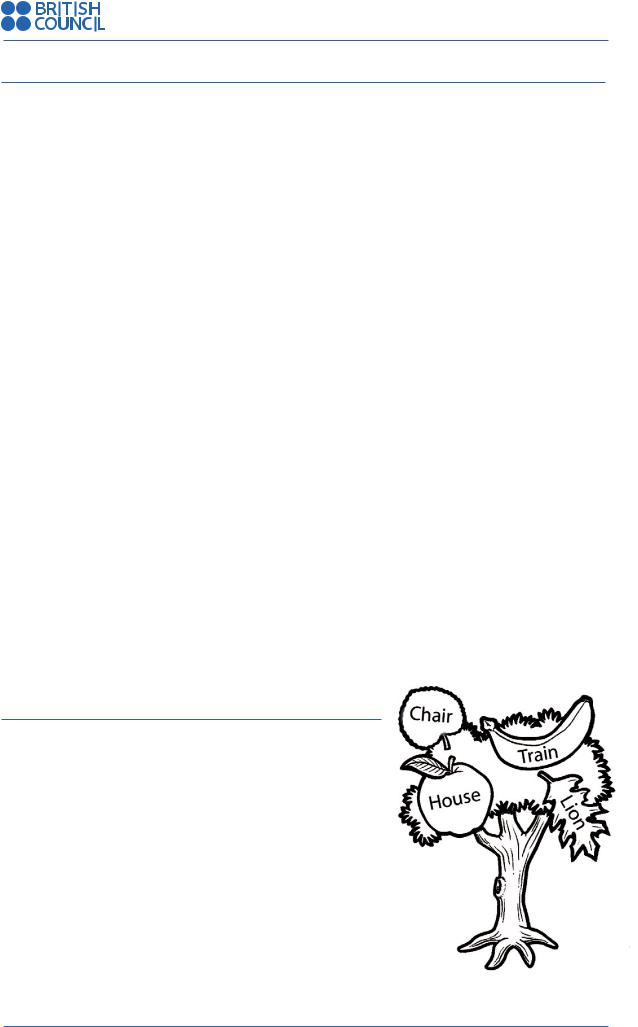
TeachingEnglish Young Learners Activity Book
Activities
Alternatives
•You can use the activity to practise or revise vocabulary sets by choosing a theme for the tree, rather than allowing the children to choose any noun. For example, a transport tree, a furniture tree, a shops tree. The children have to choose nouns related to the chosen theme.
•If you have a large class, this activity can be done in groups following the same procedure.
•You can have a verb tree or an adverb tree too.
•You can use this activity to review work; instead of asking the children to think of nouns, tell them which nouns they must write.
•Elif Olcay Bozdaş (Turkey) sent a variation on this activity called ‘New Year Tree’. For this activity you need green and brown card. Before the class, cut the green card into squares of about 15cm x 15cm. Make sure you have one square for each child. Cut the brown card into a rectangle of 20 x 30 cm. This will be the tree trunk.
1.Stick the brown card to the wall or board.
2.Give each child a square of green card and tell them to trace the outline of their hand on the square.
3.Tell the children to cut out the outline of their hand, so they have a hand-shaped piece of card.
4.Ask the children to write their name in one of the fingers on the hand and their wish for the New Year.
5.Ask each child to say something about their wish and come up and stick their hand above the ‘tree trunk’ to make the tree.
Notes
This activity does not have to be limited to New Year – you can do it at any time. You can use the activity to practise a number of different expressions, for example, the children write their favourite food/subject/singer/person/sport/place and so on. They could write a sentence about their town/their family and so on.
Acknowledgements
Elif saw this activity done by Suzan Öniz from Middle East Technical University.
No resources?
Trace out a large tree on the classroom floor using a stick. Ask the children where the trunk is and where the branches are. Proceed as above, but instead of writing down a noun, the children think of one. When they are called up, they become the leaf or fruit and stand on one of the imaginary branches.
Draw a tree trunk on the board and ask the children to come up in turn, draw a branch and write their wishes in the branch.
© British Council 2012 |
81 |
|

TeachingEnglish Young Learners Activity Book
Activities
Activity 38: The snake game
Marina Kolar – Croatia
Age: 7+  10–20 minutes Large classes? No Mixed level? Yes
10–20 minutes Large classes? No Mixed level? Yes
Materials: board and markers (either magnets or some sort of sticker, such as a sticky note), a dice.
Organisation: Whole class.
Aim: To practise or revise vocabulary and structures.
Description: Children in the class are divided into two teams. Individuals from each team must answer questions dictated by a square on the board snake.
Preparation: You will need to prepare a series of questions based on the categories in your snake (see Step 1 below).
Procedure
1.Draw a large snake on the board and divide its body into a number of squares (at least 15). In each square write a letter as a prompt to the category of question. For example, V might be a ‘vocabulary’ question; C might be ‘correct the sentence’, while O might be
‘odd man out.’
2.Divide the class into two teams. Explain the rules of the game. A member from each team comes to the front and shakes a dice. According to the number on the dice, they move forward up the snake’s body. On reaching the number, the child places the marker on the square and has to answer a question, according to the letter. If the child is not sure of the answer, they can ask the rest of the team.
3.If the child answers correctly, the marker remains on the square. If the question is answered incorrectly, the child moves the marker three squares down the snake. The winning team is the first to reach the snake’s tongue.
Notes
Other categories you might consider are ‘translation’, ‘spelling’ and ‘pronunciation’. Larger classes will need more teams.
82 |
© British Council 2012 |
|
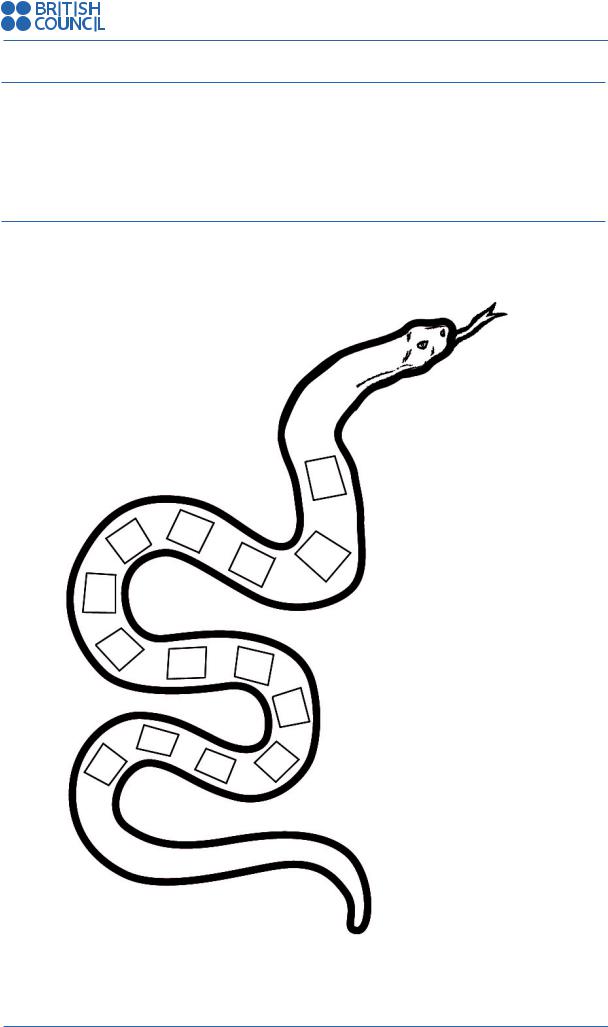
TeachingEnglish Young Learners Activity Book
Activities
Alternatives
•The children could prepare questions for each other based on the categories.
•Children from the opposing team could read out the questions in a ‘snakey’ voice. They could also decide if the answer is right or wrong (if they get it wrong, they move down the snake two spaces).
No resources?
You could draw the snake on the floor with chalk and have two children act as the ‘markers’, moving up and down the snake!
v
c
o
© British Council 2012 |
83 |
|
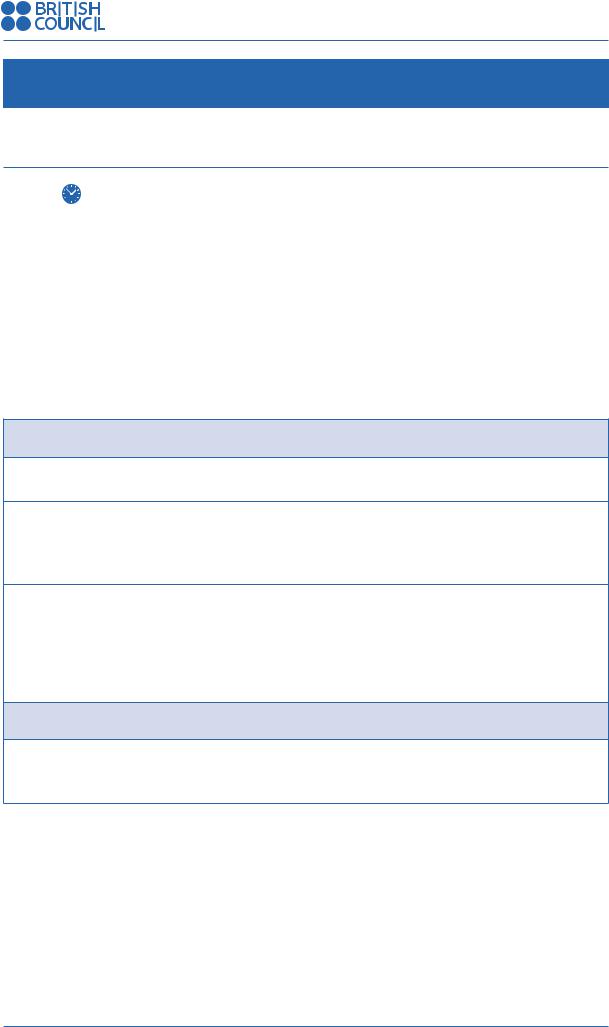
TeachingEnglish Young Learners Activity Book
Activities
Activity 39: Throwing a ball
Joanna Sanecka – Poland
Age: All |
5–30 minutes Large classes? Yes Mixed level? Yes |
Materials: Soft objects that can be thrown, such as a soft ball or toy. You’ll need one for each group.
Organisation: Whole class or large groups. Aim: To revise vocabulary.
Description: In this activity, the children take it in turns to say a vocabulary item by throwing the ball to each other. The activity can be used to practise any set of vocabulary you like. There are a number of variations on this game and one alternative is given below.
Preparation: You will need a ball (or the same number of balls as groups).
Procedure
1.Divide the class into groups of about ten. The game is played by each group at the same time. Ask the group to stand in a circle.
2.Tell the students the area of vocabulary to be used in the game, for example, months of the year, colours, animals, numbers, clothes etc. and throw the ball to a child. The child who catches the ball says another word in the series and throws the ball to another child. This child also says a word in the series and throws the ball again.
3.If a child gets a word wrong or can’t remember another item, either:
a.The child is ‘out’ and the game continues until only one child is left and is the winner.
or
b.The child changes the subject of the vocabulary group and a new round begins using the new vocabulary.
Notes
If you don’t have room for the children to stand in circles, ask them to sit around tables. If you have desks in fixed rows, they can play by going down the row and back again. You can also use a soft toy rather than a ball.
84 |
© British Council 2012 |
|
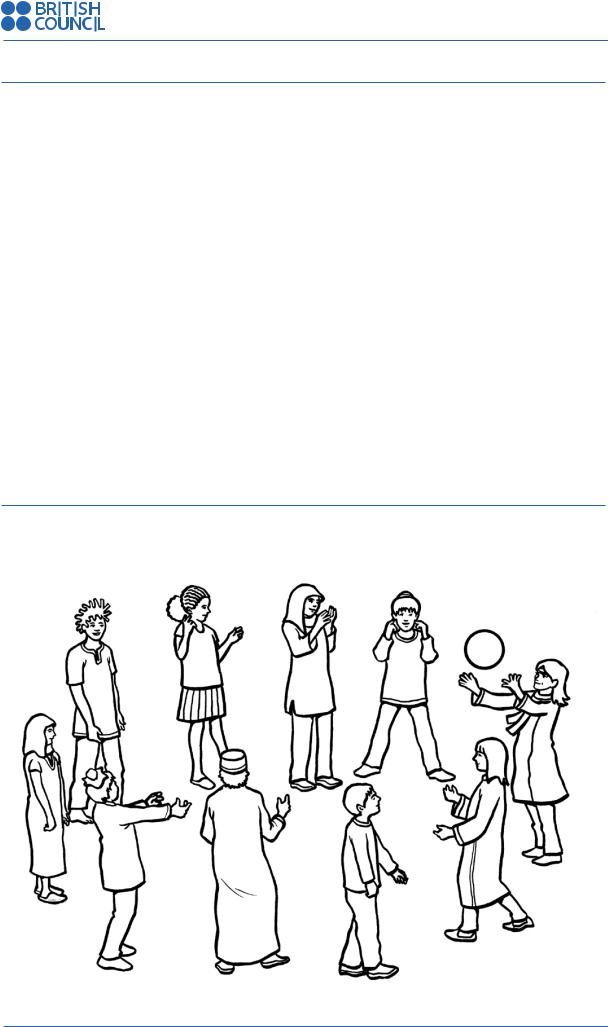
TeachingEnglish Young Learners Activity Book
Activities
Alternatives
•With younger or lower level children you can choose simple vocabulary sets with limited items and a fixed sequence, such as months, numbers, letters, days, etc. The child who catches the ball has to give the next word in the sequence.
•Ibrahim Sabatin (Palestine) suggested a similar activity which can be used when children meet each other for the first time:
1.The teacher starts the game by saying, ‘Hello, I’m Maryam’ and throws the ball to a child. The child who catches the ball introduces him/herself in the same way, throwing the ball to another child and so on.
2.Once every child has had a turn, the ball returns to the teachers, who says something else about themselves, for example, ‘I live in Hebron’ or ‘I live in Main Street’ (if all the children are from the same town) and throws the ball to a child who tells the group where they live and throws the ball to the next child and so on.
Possible prompts might be:
Hello, I’m… I live in...
My birthday’s in (month)
I like (hobbies/favourite food etc) I can (abilities/talents etc)
No resources?
You only need a ball(s) for this activity.
© British Council 2012 |
85 |
|
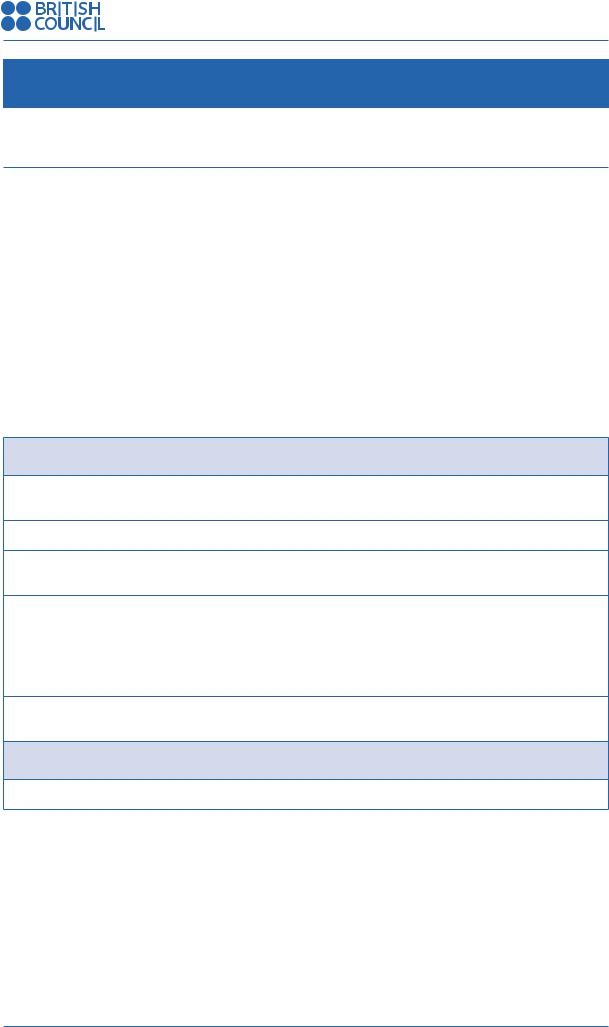
TeachingEnglish Young Learners Activity Book
Activities
Activity 40: Toothpick game
Weronika Salandyk – Poland
Age: 8+  Maximum 20 minutes Large classes? Yes Mixed level? Yes
Maximum 20 minutes Large classes? Yes Mixed level? Yes
Materials: Toothpicks and pictures of people doing things.
Organisation: Group work.
Aim: To practise making sentences describing the pictures.
Description: Children work in pairs or groups. They take it in turns to make sentences about the pictures, and use the toothpicks to show which part of the picture they are describing.
Preparation: You will need to find suitable pictures of people doing things. These can be pictures from your course book, pictures from magazines, a photocopied picture or a flashcard. The important thing is that there is a lot of activity in the picture. Make sure you have enough toothpicks to bring to class.
Procedure
1.Divide the class into pairs or groups of no more than four. Give each pair/group a set of about 12–20 toothpicks.
2.Give each pair or group a picture.
3.Tell the children that they have to take it in turns to make sentences about the pictures. Elicit some examples using one of the pictures, or a picture you put on the board.
4.Here is the fun part. As the children make a sentence, they must put a toothpick on to the picture, so that the point of the toothpick touches the part of the picture that the child is describing. The next child then makes a sentence, following the same procedure. However, this child’s toothpick must touch the picture and also the previous toothpick, like in a dominos game.
5.The children get one point for each toothpick they manage to lay down. The child who places all their toothpicks first is the winner.
Notes
You might need to cut the toothpicks in half if the pictures are small.
86 |
© British Council 2012 |
|
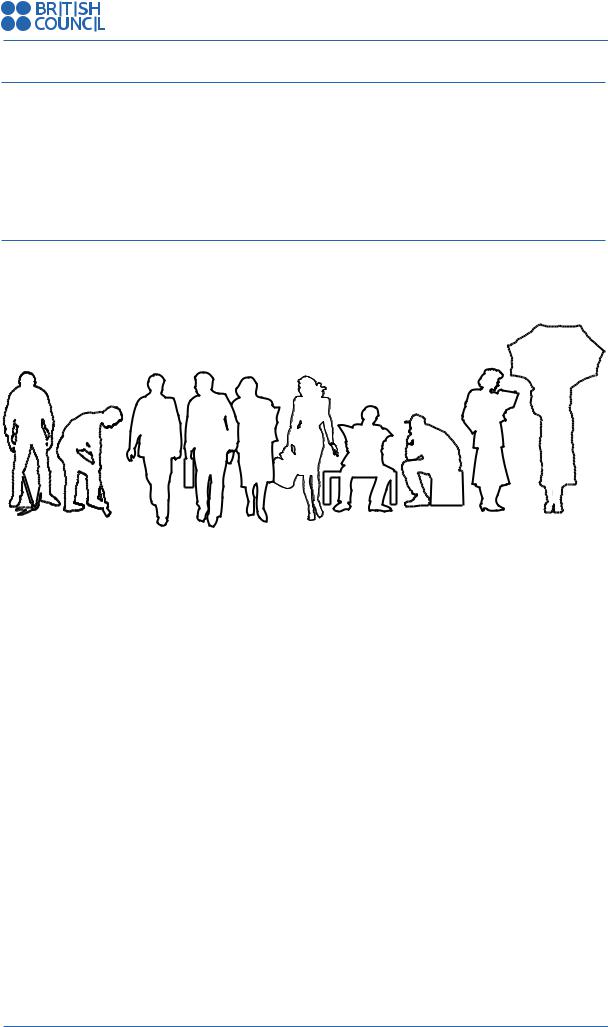
TeachingEnglish Young Learners Activity Book
Activities
Alternatives
•If you have children of different levels, you can differentiate the kind of sentences they must make. For example, lower level children can make sentences with adjectives while higher level children can make sentences with particular tense patterns.
•You can add a level of challenge by insisting that the children cannot move existing toothpicks when they lay down their toothpick, or they lose a point.
No resources?
If you do not have toothpicks, small sticks are fine. If you do not have lots of pictures, use one picture and ask one group of children to do the activity while the others watch.
© British Council 2012 |
87 |
|
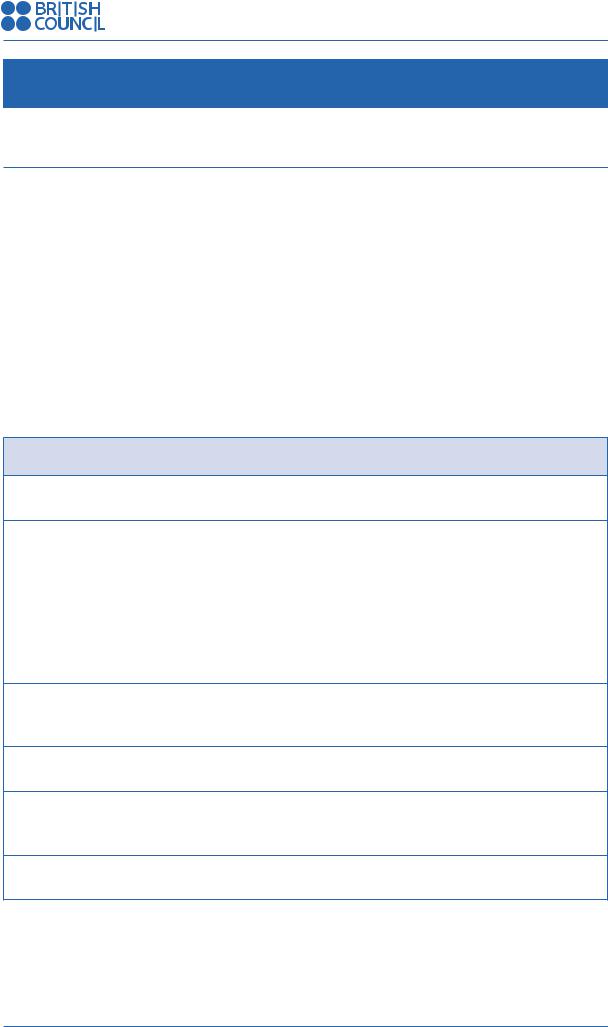
TeachingEnglish Young Learners Activity Book
Activities
Activity 41: Tourist role play
Mohammed Azaza – UAE
Age: 7+  20 minutes Large classes? Yes Mixed level? Yes
20 minutes Large classes? Yes Mixed level? Yes
Materials: Pictures of famous places in your country/area. A large map of the country/area in which you live. Tourist props such as a sun hat, camera, sunglasses and so on.
Organisation: Whole class.
Aim: To describe places that the children know both orally and in writing.
Description: Children identify local places of interest to a tourist. They produce short texts about the places and then role play a tourist visiting the different sites.
Preparation: You will need to find the pictures of famous places in your country/area and a map for the activity. These can be flashcards, photographs or cut from a magazine/tourist brochure. You will also need tourist props, or you could make these out of paper/card.
Procedure
1.Show the children pictures of famous places and areas in your country and ask the children to name them.
2.Choose one of the pictures. For example, for the UAE, it might be the desert. With the children, build up a text about the desert on the board, creating a skeleton structure the children can use to describe other pictures:
This is the desert in the UAE.
The desert is very big and very beautiful. I have been to the desert lots of times.
My favourite thing about the desert is the peace and quiet.
3.The children choose one of the pictures from Step 1 and write a text of their own. This can be done individually, or in pairs or groups, depending on the children’s level and the support they need. The children take it in turns to read out their texts.
4.Show a map of the country/area and stick the pictures and texts in the correct place on the map.
5.Show the class a picture of a tourist. Ask one of the children to come to the front to be the tourist. Give the child some props to make them feel like a tourist (for example, a hat, a camera, sunglasses, binoculars, a guidebook). Give the tourist a pointer too.
6.Ask the tourist to point to four different things on the map and to say where they have been and to describe the places. The children then take it in turns to take on the role.
88 |
© British Council 2012 |
|
